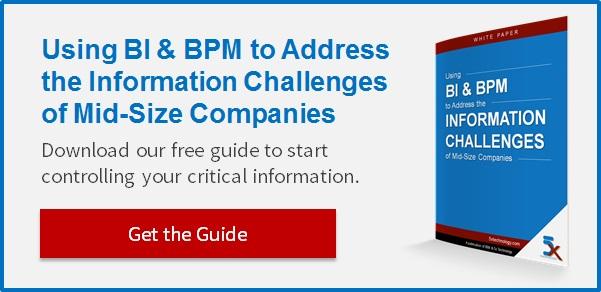
You're a professional business-enhancing champion. You generate the "ups," and you've beaten the "downs." Whether you're an HR manager, sales team lead or product manager, you know your job isn’t just about the bottom line; it’s about the big picture. But sometimes it's hard to see the forest through the trees. How do we know which combined information will lead to the right decision? That's when business intelligence comes in to give us the answers.
We’ve all heard the stories of legendary improvements from applying innovative business intelligence. Remember when the Fleet Readiness Center Southwest was awarded the role of Business Intelligence Center of Excellence after implementing report writing, universe design, and data modeling? Or when Toyota offered business intelligence strategy to a soup kitchen in NYC and turned their hour and a half wait time into a mere 18 minutes? The power of business intelligence!
We all want results like that, right? It's not as daunting as it may sound. Let's discuss how your company can use business intelligence to see the big picture.
What is Business Intelligence (BI)?
Business intelligence, or BI, improves better business decision making utilizing tools, software, and analytics to streamline processes. Business intelligence is an organization attitude that incorporates every aspect of your business. It's an umbrella term that covers not only a way of thinking but also software tools and, potentially most importantly, the application of the raw data collected by those tools to impact the day to day workings and long term strategy of your business. BI includes several connected activities, including data mining, online analytical processing, querying and reporting.
BI is so much more than plugging data into a spreadsheet. A streamlined BI strategy will give you more data than you've ever had, convert that data into valuable reporting, and lead to a detailed blueprint to improve decision making, cut costs and identify new business opportunities.
One cannot live on data alone, and the data you'll get from BI is only as good as the data that goes in. It needs reliable, experienced employees to implement and successfully analyze. With today’s BI tools, you can jump right on in there and start analyzing the data yourself. You've always relied on your gut, and there's no need to stop doing that completely. BI is a guide for your business decisions that you can back with hard data.
3 Questions to Ask Yourself Before Deploying Business Intelligence
We've discussed the importance of YOU and your team as an essential part of business intelligence. It's time to focus on the other half of the coin and walk through the software applications and tools you'll need. The right software system will be vital in streamlining your processes, driving future business concepts, increasing revenue, and can even help you learn more about your customers.
Before you begin your BI strategy, ask yourself these three simple questions. We've said it before but it's worth repeating, the data analysis you get from BI is only as good as the information you put into it. It's important that all members of your team are clear on these points before you begin gathering data. This will help you avoid any mistakes and ensure clean and correct data on the other end.
1. What are Business Intelligence Tools?
An easy question and a good place to start! The key general software categories of BI applications are:
- Spreadsheets
- Reporting and querying software: applications that extract, sort, summarize, and present selected data
- Online analytical processing (OLAP)
- Digital dashboards
- Data mining
- Business activity monitoring
- Data warehouse
2. What is Business Intelligence Reporting?
A thorough report will be a vital tool in the decision making that will follow. BI reporting involves a broad set of data analysis applications, including:
- Ad hoc analysis and querying
- Enterprise reporting
- Online analytical processing (OLAP)
- Mobile BI
- Real-time BI
- Operational BI
- Cloud and software as a service BI
- Open source BI
- Collaborative BI
- Location intelligence
3. Are There Any Business Intelligence Dashboard Examples?
Your company likely already uses independent dashboards for sales programs, social media, inventory, operations and more. It's a data visualization tool that keeps things organized, efficient, and accessible. A BI dashboards will bring together the systems your company already uses to create a comprehensive tool. It should display the current status of metrics and key performance indicators (KPIs), consolidate and arrange like data and metrics and preferably give performance scorecards on a single screen.
A custom BI dashboard will convert your unique company data tools into hard information and turn that information into valuable knowledge. This is an important next step after implementing your BI tools. It's how you'll successfully read your gathered data and move forward with the decision making phase. A BI dashboard will help your team find the right data quickly and easily. You don't have to wait and gather data from multiple sources; the answers to your questions are all at already at your fingertips.
Business Intelligence Doesn’t Have to Be Scary
But it's not a magic wand either. There's no magic formula for improving business planning. BI will give you information, structure, and templates to follow, but it's up to you to implement them. And you wouldn't want it any other way, right?! All the software in the world won't make a difference if it's not backed with passionate and innovative employees. Today's business leaders are agile, creative, cutting-edge and, most importantly, informed. A thoughtful BI strategy delivers on all these points.
As your business continues to grow, it will be your implementation of BI data that will keep you relevant and generate the ROI you need to thrive and contribute to your community. The next legendary BI story that makes the rounds on Forbes and Huffington Post could be about you. Hmmm, now that's a worthy goal!
Related: 3 Actions to Take Now for an Effective Business Intelligence Strategy




